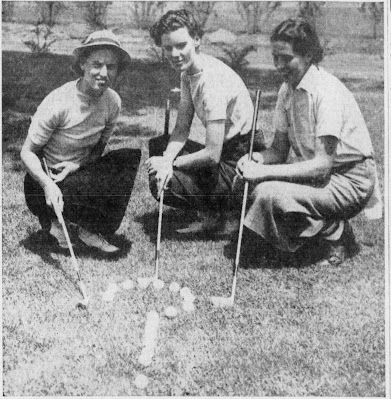I wonder how many living in Kingstree today realize that Hope Seignious, the founder of the Women's Professional Golf Association (WPGA), forerunner of the LPGA, lived the last years of her all-too-short life in Kingstree and is buried in Williamsburg Cemetery.
Born in Orangeburg County, Hope got her start in golf after the family moved to Detroit, Michigan. There, her father, G.M. Seignious, began coaching his nine-year-old daughter. Four years later she became the city's youngest golf champion by winning the Detroit Women's Public Links title at age 13. Golf, however, was not her only sport. She also played shortstop on her middle school baseball team and participated in–and won–swim meets.
Hope was a long driver. Even as a young teen, she was able to drive the ball over 200 yards. At 14, she set the new women's course record at Sylvan Glen Country Club in Detroit. At Plum Hollow Country Club, she broke all course records. She was often the youngest player in many of the tournaments in which she participated. Newspapers throughout the upper mid-west covered her regularly, calling her the "long-driving school girl golfer," or the "sensational school girl golfer."
In 1935, one newspaper compared her ambition for golf to that of Amelia Earhart's for flying.
Mrs. Don Weiss, Hope Seignious and Margaret Russell in 1938.
Source: Detroit Free Press
In June 1939, newspapers reported that she lost a seven-hole lead in the Michigan Women's District Medal Tournament but made one of the most spectacular comebacks ever seen in Michigan Women's golf as she recovered to win her fourth straight title. That year, Hope Seignious held the course record at 12 country clubs in Michigan.
During World War II, she did her part by working at an airplane plant in Detroit. However, in 1944, George Corcoran, a leading advocate for women professionals in golf, hired her as assistant pro at a country club in Greensboro, NC. As very few women were working as club pros, this announcement generated much newspaper coverage across the country. However, many of the papers seemed most concerned that she would be wearing slacks to perform her duties. Sports writers in general were not particularly kind to women golfers, describing Hope Seignious as "husky" and Lt. Patty Berg as "pudgy."
In an effort to bring women's golf to the forefront. Hope Seignious applied for a charter for the Women's Professional Golfers Association in North Carolina. The charter was granted in November 1944. She immediately began planning a WPGA championship tournament, with dreams that the association could find sponsors for other events as well. "I think people should be able to make a living at something they're good at," she was quoted as saying.
In January 1945, Hope Seignious was again on the front page of sports sections across the country as the 28-year-old accepted the position as head pro at Milwaukee's North Shore Country Club. She was not the first woman club pro, but the announcement was greeted with much skepticism. The Sheboygan Press noted that Hope had "an impressive golfing record but will have to prove herself as Wisconsin's first woman golf professional." At that time, she was a seven-time winner of Michigan women's golfing championships.
She worked at North Shore Country Club for one season before returning to Greensboro to devote more time to the WPGA, where she served as secretary/treasurer and promoter.
In March 1945, she had announced that the WPGA's first Open Championship would be played in Spokane, Washington, that August, with a total purse of $19,700. This prompted Scottish men's golfer Bobby Cruickshank to quip, "Where are my kilts? This is where I start playing in skirts."
However, the WPGA Open that year was cancelled because of transportation issues in the Spokane area. It was rescheduled, however, and played August 26 - September 1, 1946. It drew 42 competitors, including the great Babe Didrikson Zaharias, who was eliminated in the first round. Patty Berg was the winner of the tournament.
In July 1945, the first issue of Women's Golfer, a monthly magazine, appeared. It was published in Greensboro, with Hope Seignious as its editor and publisher.
The WPGA, while financially sound, struggled, as the golfing community at large did not offer its support to the women. The 1947 Women's Open was played in Greensboro with the Seigniouses largely financing the tournament.
The Ladies Professional Golf Association (LPGA) was formed in 1949-50. Hope Seignious was a member of the LPGA but did not actively participate on the circuit.
In the late 1950's G.M. Seignious left his cotton brokerage in Greensboro and moved to Kingstree where he ran the Princess Ann Motel on Longstreet. In 1961, his daughter constructed a nine-hole, par-three golf course adjacent to the motel, which was one of the first par-three courses in South Carolina. She told reporter Ann McIntosh that her immediate interest in building the course was to introduce young people to golf.
Hope Ann Seignious died at age 49 on July 11, 1968, following a cerebral hemorrhage. After her death, Louise Suggs, one of the founders of the LPGA, said, "Hope was ahead of her time, yes, sort of. But you had to know back then golf was a rich person's game. Women and girls particularly didn't play a lot. Hope had a dream, and it didn't work out."




No comments:
Post a Comment